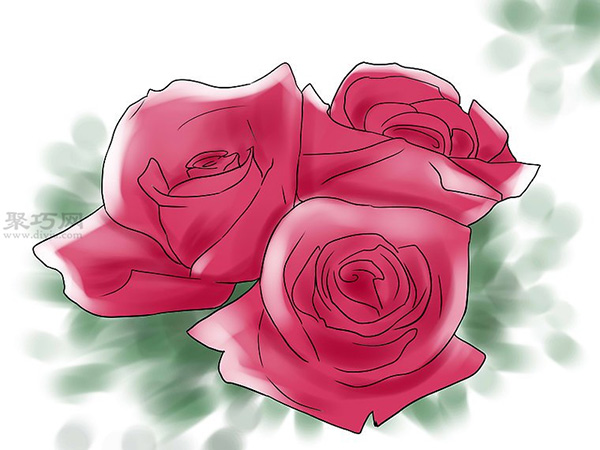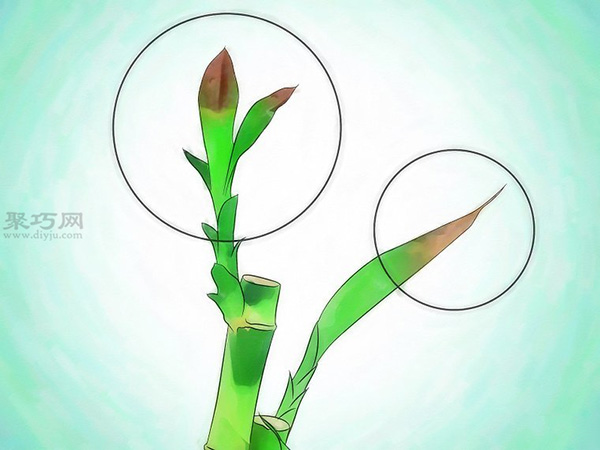A tutorial on planting roses illustrates how to grow roses
Have you ever thought of being a good rose gardener? As a representative of love and beauty, roses have been planted for thousands of years and can grow in the wild or in the garden. In order to grow good roses, you must choose the ones that suit your environment and take good care of them so that the roses grow better year after year. The following article will show you how to plant good roses.
Rose planting tutorial illustration, this manual DIY tutorial includes: pre-planting preparation, planting roses, daily care, prevent roses from being hurt, want to learn how to plant roses, see Juqiao net this rose planting tutorial illustration to learn!
Preparation before planting

Do you know that there are more than 13000 kinds of roses? Different kinds of roses have different suitable environments for growth. When you choose a flower, you need to know the characteristics of the place where you plan to plant roses. According to the characteristics of the soil, you can choose the most suitable rose variety for planting. The shape, size and color of the flowers should also be taken into account when choosing. The varieties of roses are mainly divided into the following categories:
The appearance and color of hybrid rose are very beautiful, so it often appears in the decorative bouquet of florist or banquet.
Bouquet rose is one of the most colorful varieties. There will be many flowers on each plant, rather than just a bud on each plant.
Big flower rose is a hybrid variety of hybrid rose and bouquet rose. Usually the bouquet is very high and there are several buds on each plant.
Climbing roses can be wrapped around fences and walls like vines.
Dwarf roses are small and dense in shape and are very suitable for growing in containers.
Shrubs and landscape roses are relatively easy to raise varieties, more resistant to insect pests and diseases. There is also a rich selection of shapes, sizes and colors.
A tree rose is a variety grafted on a long branch, so it looks like a tree. Tree roses need more careful care than other varieties.
After buying bare-rooted or potted roses and deciding which kind of roses you want to plant, you also have to decide how to plant them. You can choose bare-rooted flower seedlings that are planted directly in the soil, or rose seedlings that have been planted in a small flowerpot, and then transplant them to the garden or another flowerpot. You can find what you want in any nursery, and if you plan to buy rare rose varieties, you can also find it online.
Bare-root roses should be planted in early spring so that when the weather starts to warm, the planted roses can grow new roots.
Potted roses should be kept indoors all winter and taken out when spring comes.
Buy some rose gardening supplies in addition to rose seedlings, you also need some other gardening tools. You can buy the following tools from a community nursery or online store:
Pruning shears. Pruning can keep the roses in good condition, promote the formation of buds, and keep the bouquet in good shape. Pruning is important in the process of planting roses. You need a small arc shears and a big pruning shears.
Gardening gloves. To prevent stabbing, you need to prepare a pair of thick gardening gloves.
Flower fertilizer. The roses need to be fertilized several times a season. You can choose fertilizer specially designed for roses, or other kinds of flower fertilizer.
Cover the earth. Covering the rose's flower bed with soil can avoid insect pests and provide more nutrients to the rose. You can choose sawdust, pine needles, peat or any other form of cover.
Mix the rose mixture in the soil, which can help roses grow better.
Shovels and shovels. These are used to dig the earth during transplant.
Plant roses
Choose a planting site where you must make sure that you get six hours of sunlight every day. Don't have too many other flowers and trees next to you. The soil is soft and well drained. If there is too much clay, you must loosen the soil and add some gypsum particles before planting.
The pH value of the most suitable soil for rose growth is between 6.3and 6.8mm.
You can choose to check the drainage of the soil after the heavy rain. If the soil is wet but there is no stagnant water, then this area is a good choice. If you see a lot of water and mud puddles, you may need to find another place or renovate it to make the soil more suitable for roses to grow.
Replenish the rose seedlings with water before transplanting if you want to plant bare-root seedlings, you can soak the seedlings in water for several hours before transplanting. If you buy potted seedlings, water them thoroughly before moving to the flower bed.
Dig a big pit. Every flower needs a big pit. Dig a pit 50 cm square and 50 cm deep with a shovel and shovel. The size does not have to be precise. A pit of roughly this size is suitable for transplanting roses. Mix the dug soil with fertilizer and fill it back into the pit as a base. Add some bone meal or rose fat.
If you plan to plant more than one rose, be aware that the two bushes should be half a meter apart so that there is enough room for the roots to stretch.
The transplanted seedlings put the seedlings on the top of the base and fill the soil back into the pit with a shovel. The buds on the seedlings should be about 5 cm below the ground. If the temperature in the place where you live is relatively low, you can plant the seedlings deeper appropriately to ensure that the seedlings will not be damaged by the low temperature.
If you are transplanting potted seedlings, remove the sticky soil from the roots before transplanting.
Make sure the soil around the flower root is strong, and you can press it with your hands to remove the air gap.
Watering will thoroughly water the area where you transplant the seedlings, which will help the soil and the roots of the flowers to stick together more closely, and the seedlings will be more stable in the soil. It should be noted that the soil must have good water permeability.
Cover the flower bed with soil and cover all the areas where the seedlings are transplanted. If you plant roses in flowerpots, cover them with soil near the branches. This can help maintain the temperature of the seedlings (the suitable temperature for growth is 15-25 ℃), which is beneficial to the growth at the initial stage of transplantation.
Daily care
Regularly water roses in summer. Roses that grow well need a lot of water. Don't let the soil dry completely. If you see dust on the ground, it means you are short of water. For flowers that have been transplanted, choose the frequency of watering depending on your area, usually once a week.
Fertilizing roses usually need to be fertilized several times in each growing season. In early spring, you can apply fertilizer when you see new buds coming out, either liquid fertilizer or granular fertilizer. Fertilizer needs to be applied again at the first flowering, and again if there is a second flowering. At the end of summer, when Labor Day is over, fertilizing can be stopped.
Some fertilizers have a slow-release effect, and you don't need to fertilize too often with this fertilizer.
Don't fertilize too much, or it may also cause damage to the flowers.
Pruning branches and leaves can keep the flowers beautiful and healthy. Where the branches and leaves are too dense, a certain amount of pruning is needed to prevent the flowers from rotting or disease. The way of pruning varies from season to season, but the position of pruning branches and leaves is fixed: pruning from the place of budding, that is, where the branches and leaves protrude. There is usually a small circle, located on top of a large clump of leaves, which can be trimmed diagonally down.
Roses are not easily cut, because new shoots must come from the latest flower buds. You just have to choose the right place to trim, otherwise the new leaves will affect the shape of the whole flower. Remember that the trick to pruning is to cut off the new branches that grow outward to ensure good ventilation inside the flowers.
Remove withered branches and leaves in late winter and early spring. If there are new branches and roots extending from the trunk, clean up these derived branches and leaves to prevent the nutrients of the trunk from being taken away. Keep about 8 flowers and cut off the branches and leaves at the height of 1 to 3, which can make the bouquet grow better when the weather is warmer.
Pay attention to cleaning up withered flowers in summer, which can make new flowers bloom better.
To prevent roses from getting hurt.
Pay attention to the necessary protection for the flowers throughout the winter. Too high flowers may be damaged by strong winds or frosts in winter. Keep the height of the flowers no more than 1.2 meters. Tie it up with string to prepare for possible bad weather. Use mixed fertilizer as a protective base at the bottom of the flowers and cover it with a layer of straw. The protective seat can be removed when the temperature rises above 14 degrees Celsius.
Use water to wash away aphids and spiders from flowers. This pest occurs in most rose varieties, and washing with water is the most effective way to kill the pest. In addition, ensuring that enough water is given to the flowers can also effectively reduce insect pests.
Use less pesticides. Pesticides are likely to damage your roses and other plants in the garden, as well as kill other insects that are good for plant growth.
Clean up the withered leaves in time.
If the pest is still not completely cleared, try to make a mixture of dishwashing soap and water and spray it on the leaves once a week.
You can also buy some natural rose essential oil insecticides to spray on the leaves, which can inhibit pests without harming beneficial insects.
Be careful not to let your roses suffer from black spots or powdery mildew to choose rose varieties that are resistant to these diseases, such as "charming roses". You can also spray fungicides at the beginning of each season, which can also effectively prevent diseases. You can also go to the regional nursery for consultation to know what is the most effective way to eliminate the disease in your place.
Tips
A good irrigation system is important because roses are sensitive to watering.
Good pruning can give your garden a new look, and your house will get the best decoration because of it.
If you like, add a little lemon juice to the water when watering the roses on a sunny day.
Time: 2019-05-08 Click:
- Prev

How to raise a gentleman orchid
Gentleman orchids should learn to keep it this way in summer. For many flower lovers, the summer heat is a terrible existence, and many flowers will be killed unknowingly. For gentleman orchid, do you know how to maintain it in summer? Maintain the environment in summer, the weather is very hot
- Next

How to maintain rich bamboo and plant rich bamboo course diagram
How to conserve rich bamboos is part of a series of tutorials on planting rich bamboos. The tutorials also include selecting, promoting growth and maintenance. Follow this article of Juqiao Network on how to conserve rich bamboos and plant rich bamboos.
Related
- Fuxing push coffee new agricultural production and marketing class: lack of small-scale processing plants
- Jujube rice field leisure farm deep ploughing Yilan for five years to create a space for organic food and play
- Nongyu Farm-A trial of organic papaya for brave women with advanced technology
- Four points for attention in the prevention and control of diseases and insect pests of edible fungi
- How to add nutrient solution to Edible Fungi
- Is there any good way to control edible fungus mites?
- Open Inoculation Technology of Edible Fungi
- Is there any clever way to use fertilizer for edible fungus in winter?
- What agents are used to kill the pathogens of edible fungi in the mushroom shed?
- Rapid drying of Edible Fungi

